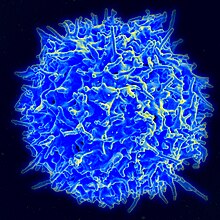| Combined immunodeficiencies | |
|---|---|
| Other names | Combined immunity deficiency, CID |
 | |
| Scanning electron micrograph of a human T lymphocyte (also called a T cell) from the immune system of a healthy donor. | |
| Specialty | Hematology |
| Symptoms | Diarrhea and sinus infections to opportunistic infections caused by mycobacteria, fungi, and vaccination reactions.[1] |
| Diagnostic method | Complete blood count, absolute neutrophil and lymphocyte count.[1] |
| Differential diagnosis | HIV.[1] |
| Treatment | Immunoglobulin therapy, antimicrobial prophylaxis, and Hematopoietic stem cell transplantation.[1] |
| Frequency | 1:100,000 to 1:5000 live births.[2] |
Combined immune deficiencies (CIDs) are a diverse group of inherited immune disorders characterized by impaired T lymphocyte development, function, or both, with variable B cell defects. The primary clinical manifestation of CID is infection susceptibility.[3] Clinical manifestations of combined immunodeficiencies vary greatly, ranging from diarrhea and sinus infections to opportunistic infections caused by mycobacteria, fungi, and vaccination reactions resulting in localized to systemic symptoms.[1]
Antibiotics and immunoglobulin replacement therapy are typically administered to patients as needed. Without hematopoietic cell or other transplantation aimed at correcting the underlying pathophysiological defect, prognosis is frequently poor due to T cell dysfunction.[4]
- ^ a b c d e Aranda, Carolina Sanchez; Guimarães, Rafaela Rola; de Gouveia-Pereira Pimentel, Mariana (2021). "Combined immunodeficiencies". Jornal de Pediatria. 97. Elsevier BV: S39–S48. doi:10.1016/j.jped.2020.10.014. ISSN 0021-7557. PMC 9432339.
- ^ Cite error: The named reference
Chavoshzadeh Darougar Momen Esmaeilzadeh 2021 pp. 9–39was invoked but never defined (see the help page). - ^ Yazdani, Reza; Tavakol, Marzieh; Vosughi Motlagh, Ahmad; Shafiei, Alireza; Darougar, Sepideh; Chavoshzadeh, Zahra; Abolhassani, Hassan; Lavin, Martin; Ochs, Hans D. (2021). "Combined immunodeficiencies with associated or syndromic features". Inborn Errors of Immunity. Elsevier. p. 41–91. doi:10.1016/b978-0-12-821028-4.00008-7. ISBN 978-0-12-821028-4. Retrieved November 20, 2023.
- ^ Su, Helen C.; Lenardo, Michael J. (2014). "Combined Immune Deficiencies". Stiehm's Immune Deficiencies. Elsevier. p. 143–169. doi:10.1016/b978-0-12-405546-9.00005-4. Retrieved November 20, 2023.